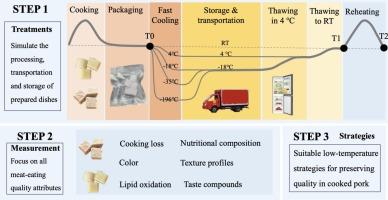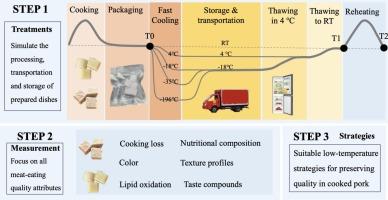通过加工和再加热研究,了解在即食肉制品中保存熟猪肉质量的低温策略
IF 9.8
1区 农林科学
Q1 CHEMISTRY, APPLIED
引用次数: 0
摘要
本研究调查了低温储存和再加热对即食猪肉菜肴质量的影响。通过冷藏(4 °C)、冷冻(- 18 °C、- 35 °C)或液氮(LN)快速冷却保存熟瘦肉和肥肉,然后再加热。冷藏保存了肉质,但增加了蒸煮损失(3.15% %瘦肉,4.2 %脂肪)和过氧化值(PV),其中瘦肉的PV增加3.5倍,肥肉的PV增加1.4倍。- 35 °C冷冻最大限度地减少了脂质氧化(脂肪猪肉的TBARS为0.16 mg MDA/kg),但增加了再加热损失(瘦肉38.2% %,脂肪44.5% %)。LN造成的损害最大,硬度下降52.4 %,肥肉脂肪减少51.5 %,TBARS升高16倍。颜色值(a*, b*)和味道化合物(NMS, ANS)也随LN下降。在- 18 °C冷冻保存瘦肉最好,而- 35 °C冷冻保存肥肉最好。低温冷却不适用于即食猪肉。这些研究结果为优化RTE猪肉的冷冻、再加热策略提供了基准。本文章由计算机程序翻译,如有差异,请以英文原文为准。


Insights into low-temperature strategies for preserving cooked pork quality in ready-to-eat meat products through processing and reheating studies
This study investigated how low-temperature storage and reheating affect the quality of ready-to-eat (RTE) pork dishes. Cooked lean and fatty pork were stored via refrigeration (4 °C), freezing (−18 °C, −35 °C), or liquid nitrogen (LN) rapid chilling, then reheated. Refrigeration preserved texture but increased cooking loss (3.15 % lean, 4.2 % fatty) and peroxide values (PV), with PV rising 3.5-fold in lean and 1.4-fold in fatty meat. Freezing at −35 °C minimized lipid oxidation (TBARS 0.16 mg MDA/kg in fatty pork) but raised reheating loss (38.2 % lean, 44.5 % fatty). LN caused the most damage—hardness dropped 52.4 %, fatty meat lost 51.5 % fat and showed a 16-fold TBARS rise. Color values (a*, b*) and taste compounds (NMS, ANS) also declined with LN. Freezing at −18 °C best preserved lean meat, while −35 °C was optimal for fatty cuts. LN chilling is unsuitable for RTE pork. These findings offer benchmarks to optimize freezing, reheating strategies for RTE pork quality, stability.
求助全文
通过发布文献求助,成功后即可免费获取论文全文。
去求助
来源期刊

Food Chemistry
工程技术-食品科技
CiteScore
16.30
自引率
10.20%
发文量
3130
审稿时长
122 days
期刊介绍:
Food Chemistry publishes original research papers dealing with the advancement of the chemistry and biochemistry of foods or the analytical methods/ approach used. All papers should focus on the novelty of the research carried out.
 求助内容:
求助内容: 应助结果提醒方式:
应助结果提醒方式:


